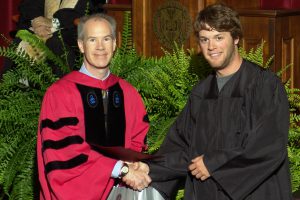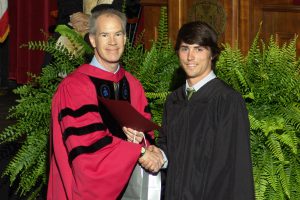Collaborating with Dr. Tappey Jones in the Chemistry Department at VMI, Dr. Shear has been working on the chemical defenses of soil arthropods. Interesting results have included the discovery of compounds new to arthropods, and at least two molecules that have not been found previously in nature.
Two groups of soil and litter-dwelling arthropods that use chemical weapons for defense are opiliones (harvestmen or daddy-long-legs) and millipedes (thousand-leggers). Harvestmen produce their chemicals from a pair of glands near the front of the body, while millipedes have paired glands on most of their many segments. The secretions range from the merely unpleasant (aromatic long-chain alcohols and ketones) through the corrosive (hydroquinones and phenolic compounds) to the lethal (hydrogen cyanide). In both groups of animals it appears that the nature of the secretions correlates with evolutionary relationships. For example, all millipedes of the orders Julida, Spirobolida and Spirostreptida use quinones for defense. Harvestmen in the family Sclerosomatidae (our familiar daddy-long-legs) produce alcohols and ketones.
However, some groups get pretty exotic. We have recently identified a complex mixture of compounds from the tiny harvestman Erebomaster acanthina, which occurs mostly in caves and crevices in the midwest. Components of the secretion include alkaloids like nicotine, but also benzothiazoles, salicyl alcohol and a coumarin! The major component is an alkaloid related to nicotine, anabaseine. Anabaseine is being investigated as possible drug for use in treating Alzheimer’s disease; it is also found in the venoms of ants and of ribbon worms.
One of our local centipedes (Hemiscolopendra marginata) has also been investigated. We found a recently discovered molecule called jineol, which has highly cytotoxic effects and may be used by the animals to protect their eggs and young against bacterial and fungal infections. Dr. Jones and one of his students have developed a new synthetic procedure for jineol and our results will be published later in the Journal of Natural Products. It is exciting that we have also found a totally unknown compound accompanying jineol, and Dr. Jones is working with students to elucidate its structure.
Drs. Shear and Jones will participate in a grant proposal from a colleague at the University of San Diego to continue this work and investigate ways in which it might provide evidence for the evolution of the animals involved. While Dr. Jones has already involved students, Dr. Shear is still looking for candidates at Hampden-Sydney to participate in the research. Any takers?




